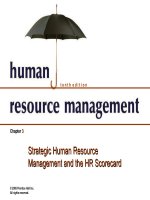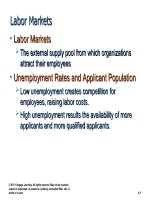Strategic human resource management ch06
Bạn đang xem bản rút gọn của tài liệu. Xem và tải ngay bản đầy đủ của tài liệu tại đây (325.12 KB, 34 trang )
1
Chater 6
Employee Testing and Selection
Why Careful Selection is Important
The Importance of
Selecting the Right
Employees
Organizational
Performance
Costs of
Recruiting and
Hiring
Legal
Obligations and
Liability
6–2
Avoiding Negligent Hiring Claims
• Carefully scrutinize information on employment
applications.
• Get written authorization for reference checks, and
check references.
• Save all records and information about the applicant.
• Reject applicants for false statements or conviction
records for offenses related to the job.
• Take immediate disciplinary action if problems arise.
6–3
Basic Testing Concepts
• Reliability
Consistency of scores obtained by the same person when
retested with identical or equivalent tests.
Are test results stable over time?
Ways to estimate reliability
Retest Estimate
– Same test to same people at different point in time
Equivalent form estimate
– Administer a test and administer what believes to be an equivalent
test.
Internal comparison estimate
– Administer a test & statistically analyze the degree to which responses
of items vary. Apparently repetitive questions on some questionnaire
to check internal consistency.
• Validity
Indicates whether a test is measuring what it is supposed to be
measure.
Does the test actually measure what it is intended to measure?
6–4
FIGURE 6–1
Sample Picture Card from Thematic Apperception Test
Source: Reprinted by permission of the publishers from Henry A. Murray, THEMATIC
APPERCEPTION TEST, Plate 12F, Cambridge, Mass: Harvard University Press, 1943.
6–5
Types of Validity
Test
Validity
Criterion
Validity
Content
Validity
Face
Validity
6–6
How to Validate a Test
Steps in Test Validation
1
Analyze the Job: predictors and criteria
2
Choose the Tests: test battery or single test
3
Administer the Tests: concurrent or predictive validation
4
Relate Your Test Scores and Criteria: scores versus
actual performance
5
Cross-Validate and Revalidate: repeat Steps 3 and 4
with a different sample
6–7
TABLE 6–1
Testing Program Guidelines
1. Use tests as supplements.
2. Validate the tests.
3. Monitor your testing/selection program.
4. Keep accurate records.
5. Use a certified psychologist.
6. Manage test conditions.
7. Revalidate periodically.
6–8
Test Takers’ Individual Rights and
Security
Test
• Under the APA’s standard for educational and
psychological tests, test takers have the right:
To privacy and information.
To the confidentiality of test results.
To informed consent regarding use of these results.
To expect that only people qualified to interpret the
scores will have access to them.
To expect the test is fair to all.
6–9
Legal Privacy Issues
• Defamation
Libeling or slandering of employees or former
employees by an employer.
• Avoiding Employee Defamation Suits
1. Train supervisors regarding the importance of
employee confidentiality.
2. Adopt a “need to know” policy.
3. Disclose procedures impacting confidentially of
information to employees.
6–10
Using Tests at Work
• Major Types of Tests
Basic skills tests
Job skills tests
Psychological tests
• Why Use Testing?
Increased work demands = more testing
Screen out bad or dishonest employees
Reduce turnover by personality profiling
6–11
Computerized and Online Testing
• Online tests
Telephone prescreening
Offline computer tests
Online problem-solving tests
6–12
Types of Tests
What Tests
Measure
Cognitive
(Mental)
Abilities
Motor and
Physical
Abilities
Personality
and
Interests
Achievement
6–13
FIGURE 6–5
Type of Question Applicant Might Expect on a Test of
Mechanical Comprehension(cognitive ability)
6–14
FIGURE 6–6
Sample Personality Test Items
Source: Elaine Pulakos, Selection Assessment
Methods, SHRM Foundation, 2005, p. 9.
Reprinted by
permission of Society
for Human Resource
Management via Copyright
Clearance Center.
6–15
The “Big Five”
Extraversion
Conscientiousness
Agreeableness
Emotional Stability/
Neuroticism
Openness to
Experience
6–16
Work Samples and Simulations
Measuring Work
Performance Directly
Work
Samples
Management
Assessment
Centers
Video-Based
Situational
Testing
Miniature
Job Training
and
Evaluation
6–17
FIGURE 6–7
Example of a Work Sampling Question
6–18
Management Assessment Centers
2 to 3 days simulations. Typical tasks include:
• The in-basket
• Leaderless group discussion
• Management games
• Individual presentations
• Objective tests
• The interview
6–19
TABLE 6–2
Evaluation of Assessment Methods on Four Key Criteria
Assessment Method
Validity
Adverse Impact
Costs
(Develop/
Administer)
Cognitive ability tests
High
High (against minorities)
Low/low
Somewhat favorable
Job knowledge test
High
High (against minorities)
Low/low
More favorable
Personality tests
Low to
moderate
Low
Low/low
Less favorable
Biographical data
inventories
Moderate
Low to high for different types
High/low
Less favorable
Integrity tests
Moderate
to high
Low
Low/low
Less favorable
Structured interviews
High
Low
High/high
More favorable
Physical fitness tests
Moderate
to high
High (against females and
older workers)
High/high
More favorable
Situational judgment tests
Moderate
Moderate (against minorities)
High/low
More favorable
Work samples
High
Low
High/high
More favorable
Assessment centers
Moderate
to high
Low to moderate, depending
on exercise
High/high
More favorable
Physical ability tests
Moderate
to high
High (against females and
older workers)
High/high
More favorable
Applicant Reactions
Note: There was limited research evidence available on applicant reactions to situational judgment tests and physical ability tests. However,
because these tests tend to appear very relevant to the job, it is likely that applicant reactions to them would be favorable.
Source: Elaine Pulakos, Selection Assessment Methods, SHRM Foundation, 2005, p. 17. Reprinted
by permission of Society for Human Resource Management via Copyright Clearance Center.
6–20
Background Investigations and
Reference Checks
• Investigations and Checks
Reference checks
Background employment checks
Criminal records
Driving records
Credit checks
• Why?
To verify factual information provided by applicants.
To uncover damaging information.
6–21
Background Investigations and
Reference Checks (cont’d)
Former Employers
Current Supervisors
Sources of
Information
Commercial Credit
Rating Companies
Written References
Social Networking Sites
6–22
Limitations on Background Investigations
and Reference Checks
Legal
Issues:
Defamation
Employer
Guidelines
Background
Investigations
and
Reference Checks
Legal
Issues:
Privacy
Supervisor
Reluctance
6–23
Making Background Checks More
Useful(guidelines)
1. Include on the application form a statement for
applicants to sign explicitly authorizing a
background check.
2. Use telephone references if possible.
3. Be persistent in obtaining information.
4. Use references provided by the candidate as
a source for other references.
5. Ask open-ended questions to elicit more
information from references.
6–24
Using Preemployment Information Services
Acquisition and Use of Background Information
1
Disclosure to and authorization by applicant/employee
2
Employer certification to reporting agency
3
Providing copies of reports to applicant/employee
4
Notice of adverse action to applicant/employee
6–25









